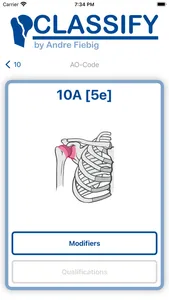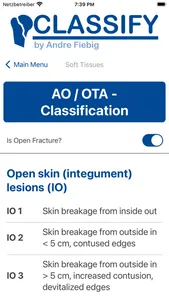"Classify" is a useful tool to classify fractures in the adult human body. The second reversion of "AO/OTA's Fracture and Dislocation Compendium" from 2018 led to some major changes in the AO classification system using "qualifications" and "modifiers". With these sub-classifications the system became - beside being very precise in fracture classification - very complex and less handy for the daily business.
As trauma surgeons we need to classify a lot of fractures every day. So I created this application to easily browse through the body regions and refine the fracture code step by step by just clicking on the fractured body part and selecting the type of fracture - shown as picture and descriptive text. In the end of this process you can precise your classification even more by selecting global modifiers. Furthermore a list of fracture specific "qualifications" (if there are some for the chosen fracture) is presented to you. That way you can easily classify and specify complex fractures.
FRACTURES:
The current version supports a fracture classification system for the following body parts in adults:
- Humerus
- Scapula
- Clavicula
- Thorax (Sternum and Ribs)
- Radius
- Ulna
- Wrist, Metacarpals and Phalanx
- Spine
- Pelvis
- Femur (including Patella)
- Tibia
- Fibula
- Melleolar Segment
- Hintfoot, Midfoot
- Metatarsals and Toes
DISLOCATIONS:
The current version supports a dislocation classification system for the following joints in adults:
- Shoulder
- Ellbow
- Wrist and Fingers
- Hip
- Knee
- Ankle and Foot
PERIPROTHTETIC FRACTURES:
The current version supports a classification system for periprothtetic fractures for the following joints in adults:
- Shoulder
- Ellbow
- Wrist
- Hip
- Knee
- Ankle
SOFT TISSUES:
Last but not least there is a classification system for the soft tissue damage in open and closed fractures (AO/OTA-Classification).
CREDITS:
The whole content of this App is based an the AO/OTA-Classification from 2018 which was published in the 'Journal of Orthopaedic Trauma' (ISSN 0890-5339), Volume 32 in January 2018 (DOI: 10.1097/BOT.0000000000001063). The classification-system for the spine is based on ©2020 AO Foundation, AO Spine. Thanks to this organizations for their excellent work!
FINALY:
There is no grant for correctness or completeness of this classification-app. All images are drawn by hand from a non professional artist. So it is possible, that some images doesn't represent the anatomy correctly or doesn't fit the fracture discription perfectly. Feel free to give me helpful und explicit feedback to make further versions better.
As trauma surgeons we need to classify a lot of fractures every day. So I created this application to easily browse through the body regions and refine the fracture code step by step by just clicking on the fractured body part and selecting the type of fracture - shown as picture and descriptive text. In the end of this process you can precise your classification even more by selecting global modifiers. Furthermore a list of fracture specific "qualifications" (if there are some for the chosen fracture) is presented to you. That way you can easily classify and specify complex fractures.
FRACTURES:
The current version supports a fracture classification system for the following body parts in adults:
- Humerus
- Scapula
- Clavicula
- Thorax (Sternum and Ribs)
- Radius
- Ulna
- Wrist, Metacarpals and Phalanx
- Spine
- Pelvis
- Femur (including Patella)
- Tibia
- Fibula
- Melleolar Segment
- Hintfoot, Midfoot
- Metatarsals and Toes
DISLOCATIONS:
The current version supports a dislocation classification system for the following joints in adults:
- Shoulder
- Ellbow
- Wrist and Fingers
- Hip
- Knee
- Ankle and Foot
PERIPROTHTETIC FRACTURES:
The current version supports a classification system for periprothtetic fractures for the following joints in adults:
- Shoulder
- Ellbow
- Wrist
- Hip
- Knee
- Ankle
SOFT TISSUES:
Last but not least there is a classification system for the soft tissue damage in open and closed fractures (AO/OTA-Classification).
CREDITS:
The whole content of this App is based an the AO/OTA-Classification from 2018 which was published in the 'Journal of Orthopaedic Trauma' (ISSN 0890-5339), Volume 32 in January 2018 (DOI: 10.1097/BOT.0000000000001063). The classification-system for the spine is based on ©2020 AO Foundation, AO Spine. Thanks to this organizations for their excellent work!
FINALY:
There is no grant for correctness or completeness of this classification-app. All images are drawn by hand from a non professional artist. So it is possible, that some images doesn't represent the anatomy correctly or doesn't fit the fracture discription perfectly. Feel free to give me helpful und explicit feedback to make further versions better.
Show More




